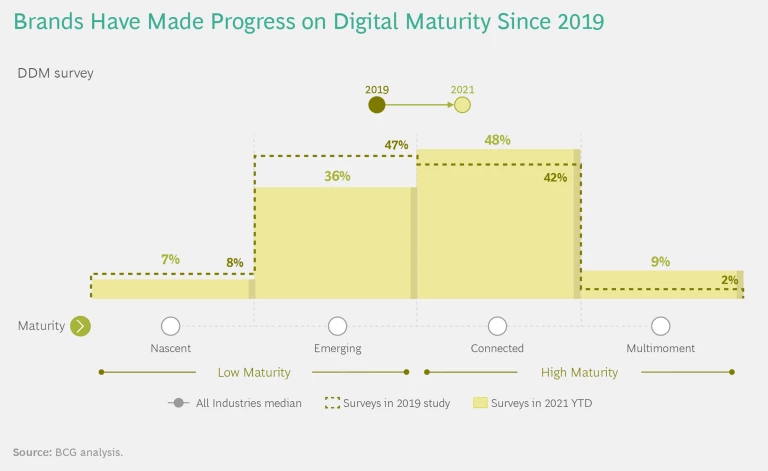Where Digital Marketing Maturity Is Going
For CMOs and their digital marketing organizations, the changes of the past 18 months have come fast, and their full impact has yet to be felt. Two big shifts stand out. The pandemic compressed several years of digital market evolution into a few months as consumers raced online to do everything from purchasing daily necessities to seeking medical treatment. At the same time, the data stream provided by third-party cookies—one of the critical supports of precision digital marketing—began to dwindle as the industry and regulators reacted to growing concerns about privacy. Meanwhile, consumers’ expectations for more customized, even personalized, outreach and interaction continued to grow.
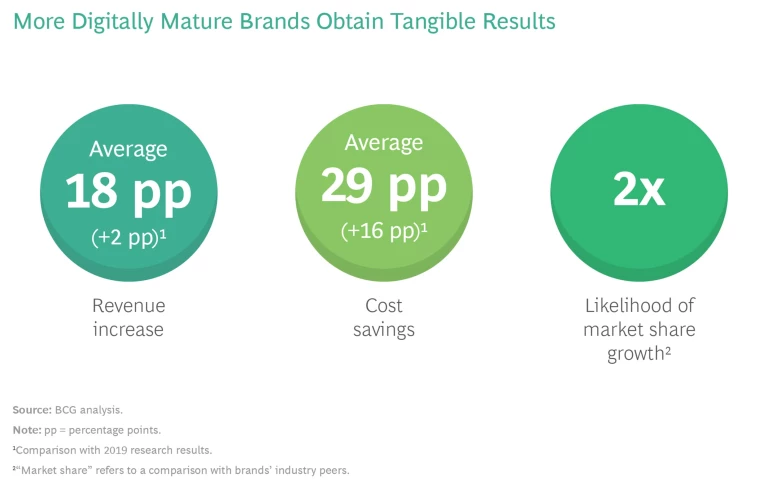
Many companies have responded to these sea changes with speed and agility. Others have been slower to react. The big difference is the extent to which each company has advanced its digital marketing maturity.
New BCG research in 2021 has found that more mature brands increased their sales by an average of 18 percentage points more than their less mature peers (2 more than in 2019) and boosted cost efficiencies by an average of 29 percentage points (16 more than in 2019). These companies outperformed on market share as well, with more than twice as many digitally mature brands increasing their share in the past year—by 3 percentage points or more on average—than low-maturity brands. (See Exhibit 1.)
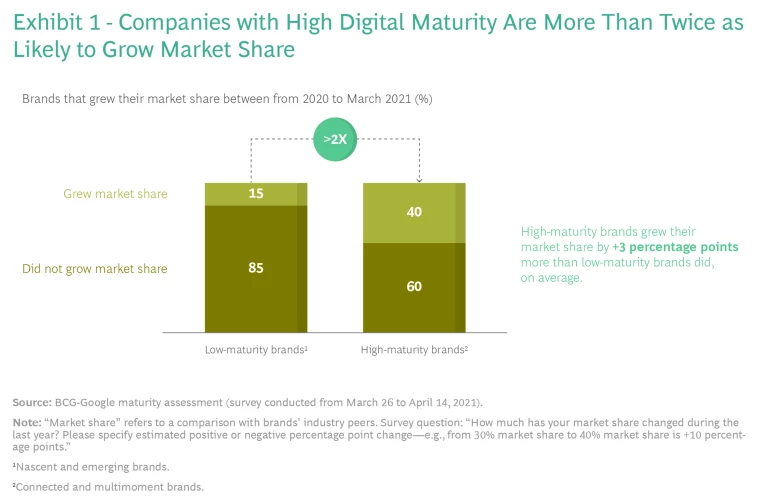
In the case of digital marketing, the race belongs to the swift, which means that less mature companies need to accelerate their efforts to catch up. Companies that have advanced quickly are reaping the rewards of those gains while companies that are treading water or making only gradual headway are falling farther behind their more mature competitors.
CMOs understand the potential upside of digital marketing maturity. The diminishing role of third-party cookies underscores the situation’s urgency. Still, CMOs encounter multiple challenges as they try to boost their organization’s maturity. The curve gets steeper as it rises, increasing the difficulty of moving to the next level. For many large companies, generating the momentum needed to carry them up the curve requires an organization-wide effort that often must surmount internal hurdles. C-suite leadership and concerted teamwork across senior management are key catalysts and drivers of success. More than 80% of the most digitally mature brands say that they have CEO sponsorship for data-driven marketing initiatives, whereas less than half of other brands do. As we have shown in the past, having the necessary enablers in place provides a foundation for making rapid, lasting progress.
In 2019, BCG research found that companies self-divided into four levels of digital maturity: nascent, emerging, connected, and multimoment. About 90% of the brands included in that survey split almost equally between the emerging and connected categories.
Our latest research, conducted in 2021, found areas of significant improvement: 13% more companies had moved into the top two digital marketing levels, and the multimoment category, in particular, registered a big jump from 2% to 9%. But most companies are still trying to break out of a muddle in the middle categories. (See “A Muddled Maturity Curve.”)
A Muddled Maturity Curve
In 2019 we assessed the digital maturity of about 180 marketers around the world and found that companies fell into four categories, with almost 90% of them grouped in the middle two:
- Nascent. Marketing campaigns use mainly external data and direct buys, with limited linkage to sales.
- Emerging. Marketers make some use of owned data in automated buying, with single-channel optimization and testing.
- Connected. Companies rely on data integrated and activated across digital channels, with demonstrated linkage to ROI or sales proxies.
- Multimoment. Organizations optimize dynamic execution across channels throughout the customer journey to achieve business outcomes.
In 2021 we thought it was time to refresh our perspective in light of marketplace changes and technology advances. In this round of research, which was again commissioned by Google and which involved 67 European, Middle Eastern, and African brands in ten countries, about 84% fell into the emerging and connected categories, along with about 7% nascent players and about 9% multimoment firms. (See the exhibit.)
The limited progress on this front may reflect the difficulty that companies have with digital transformations generally. Separate BCG research has shown that 70% of these programs fail to achieve their objectives. The four accelerators highlighted in this report can help companies radically improve their chances of success by speeding the embedding of the digital enablers that our 2019 marketing research identified as being critical to increasing digital maturity.
The research consisted of multiple qualitative and quantitative components:
- Workshops and interviews to define new hypotheses for digital marketing maturity
- 25 “belief audits” with experts, agencies, and brands
- Surveys of senior executives of 67 brands in six industries—automotive, retail, consumer goods, finance, technology and telecommunications, and travel
- More than 15 in-depth interviews that primarily focused on examples of best practice
In the handful of years since we introduced the model that we use for assessing maturity—including the enablers that define digitally advanced marketers—numerous consumer-facing companies and their tech and advertising partners have adopted the model. (See Exhibit 2.)
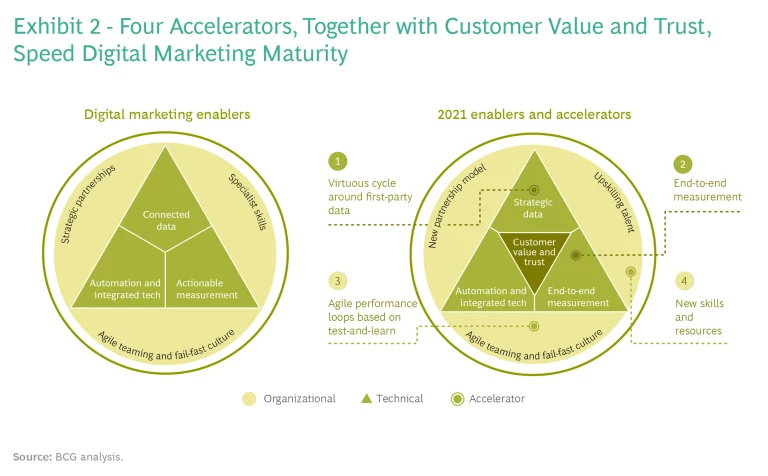
In the midst of the changes taking place, our new study isolated four specific accelerators that stand out as the principal drivers on the fast track to maturity today:
- Building a virtuous cycle around first-party data
- Developing a true end-to-end measurement capability across channels, using predictive models
- Setting up agile performance loops based on a test-and-learn approach
- Securing access to new skills and resources
These accelerators are enabling the companies that adopt them to ascend the maturity curve much more quickly than their peers and competitors.
One additional critical factor demands special attention: consumer trust. BCG has been conducting research and writing about online privacy and consumer trust for the better part of a decade. As early as 2013, we pointed out that trust is fragile and elusive. More recently, in May 2020, we highlighted the issue of trust as a crucial element in companies’ ability to gain access to first-party data with transparency and use it to enhance their value proposition. As we noted then, consumers are much more likely to share data with companies that they trust; they mainly just want those companies to ask. At its core, data best practice serves a two-way value exchange: the company gains the ability to deliver a better customer experience and more-effective marketing, and the customer gains useful information, assistance, and offers. This puts trust and value at the center of effective digital marketing.
Companies that maintain their focus on customer value and trust—and combine C-suite leadership with the four accelerators—will find themselves pointed toward the shortest and quickest route to improvement.
The Trends Driving Digital Engagement
Each of the three principal trends driving the need for companies to accelerate their digital marketing has its own shape and impact. But taken together, they are raising the stakes for less mature marketing organizations to take action. (See Exhibit 3.)
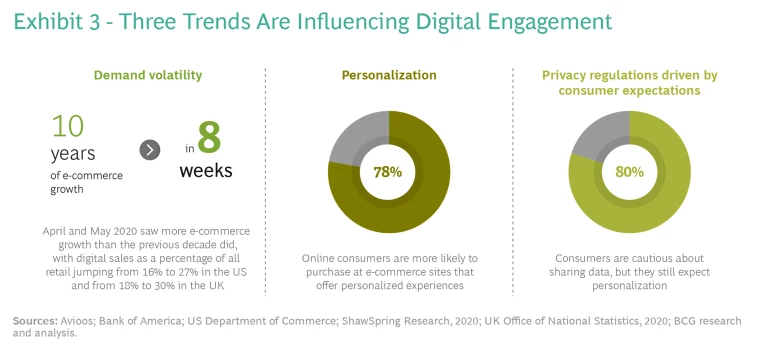
People have gradually been doing more online for years, but the pandemic boosted both the number of online users and the extent of their activities. Research shows that in sectors ranging from financial services to consumer goods more people are doing more discovery, familiarization, validation, and buying online. These include people who have never used digital channels for commerce before.
In the years before COVID-19 hit, a rapid expansion of personalization in marketing was already underway—and since then, the consumer expectations that personalized outreach creates (for both digital and offline engagement) have been growing faster than ever. In response, leading brands are finding ways to adapt as technology enables new capabilities. For example, advanced marketers are starting to use AI-generated creative content to deliver relevant messages to segmented customers at scale.
Although customers expect more relevant, personalized marketing, they remain cautious about sharing their data. And as consumer privacy concerns evolve, regulatory shifts and new industry data practices, such as Apple’s rules for identifying users to advertisers, are following.
The loss of third-party data is a relatively recent development, but we foresee a day when third-party cookies will be a tool of the past, removing a key structural component of countless precision digital marketing campaigns.
All of these changes are elevating the importance of solutions such as alternative technologies and reliable, plentiful first-party data for marketers. The new landscape will necessitate new tradeoffs and will alter how companies can most effectively engage with customers and consumers online.
These are not passing trends. They will continue to gain speed going forward. Companies that lack the digital capability to react quickly will lose ground to those that have set themselves up to move quickly.
The Fast Track to Maturity Today
The six digital marketing enablers that we identified in 2019 remain critical to digital success. But in response to the changes now taking place in consumer behavior and marketplace dynamics, advanced marketers are focusing on specific ways to augment and expand their digital capabilities. Our most recent research, which included 25 “belief audits” with experts, agencies, and brands, as well as a quantitative analysis of input from senior marketing executives, identified four accelerators that today’s fast-maturing brands apply:
- Build a virtuous cycle around first-party data in order to address privacy concerns and maintain customer value and trust.
- Develop a true end-to-end measurement capability that includes predictive models to replace data from third-party cookies.
- Set up agile performance loops based on a test-and-learn approach to break down silos and be better prepared to address future demand volatility.
- Secure new skills and resources to help ensure continuous improvement.
Our statistical modeling shows that these accelerators have become the primary determinants of digital maturity.
Although our analysis also shows that the two technical accelerators have twice the impact of the two organizational accelerators, the four complement one another and speed overall maturity. For that reason, top digital marketers work on them together. End-to-end measurement, for example, is essential to building an effective first-party data cycle as well as to driving agile performance loops and testing new hypotheses. In the same vein, a company will find it impossible to implement the first three accelerators unless it has the proper skills and resources in place.
Furthermore, our research demonstrates that brands that develop the four accelerators in parallel encounter smaller gaps among them and reach higher stages of overall maturity more quickly. For example, for companies that are moving up the curve from emerging to connected or from connected to multimoment, the gaps between accelerators are 25% to 30% smaller than those for companies that are stuck in place.
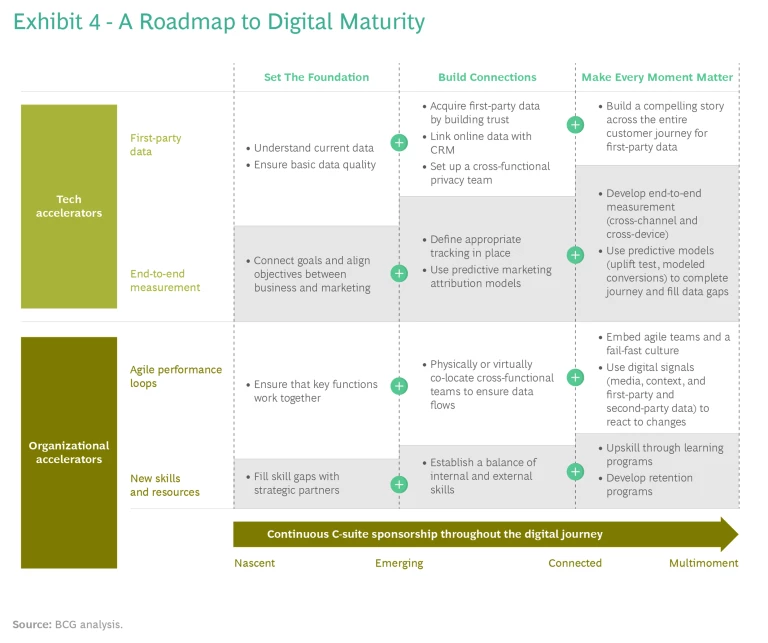
Even within the same stage of maturity, brands that show greater balance in developing the four accelerators generate better business results. High-maturity brands that manage the development properly can gain an additional 2 percentage points of revenues and efficiencies compared with their peers. At the other end of the maturity curve, 95% of companies tend to prioritize developments in end-to-end measurement and agile while deemphasizing first-party data and skills and resources. For two-thirds of these companies, the lack of progress on the latter two accelerators holds them back by a full maturity step.
Climbing the digital maturity curve takes time and hard work, but progress yields results along the way, which builds momentum. At all levels of maturity, active and visible C-level leadership is a must, as is cultivating and preserving customer value and trust at the core. To clarify what needs to happen and when, we have devised a roadmap for implementing the four accelerators. (See Exhibit 4.) Both the technical and the organizational requirements for further progress become increasingly sophisticated as companies become more mature.
Accelerator 1: First-Party Data
In the past year or two, privacy concerns and regulatory changes have increased the importance of first-party data, which helps companies keep value and trust at the center of the customer relationship by providing a transparent response to consumer and regulatory concerns. In addition, our research has shown that companies that link all of their first-party data sources can generate 1.5 times the incremental revenue from a single ad placement, communication, or outreach, and double the improvement in cost efficiency over companies that have more limited data integration capabilities.
The most important objective is to gain and maintain access to the data itself. Sophisticated marketers in the connected and multimoment categories reinforce value and trust by pursuing a three-step process to build virtuous data cycles:
- Strategy. They define a clear strategy for the first-party data needed.
- Value. They develop a compelling value proposition for the consumer or customer exchange.
- Testing. They leverage multiple iterations of testing with consumers to perfect campaign execution and learn which experiences most effectively promote the value-consent exchange.
The process also has an important technology component. Most multimoment companies use marketing technology effectively, and nine out of ten marketers say that first-party data is important to their digital marketing programs. But less than a third have mastered accessing and integrating data across channels, and very few are good at using data to create better outcomes for customers. This does not mean it cannot be done. As a retail executive put it, “Being able to link online data to offline data was a relatively easy process that was up and running in about four months. Customer data platforms allowed us not to be so reliant on cookie technology.”
Using first-party data in this way is a fairly new priority for marketers, and maintaining customer trust is as important as gaining it in the first place. Salesforce.com’s 2020 State of the Connected Customer survey found that 60% of customers see a “major need” for businesses to improve their trustworthiness and 32% see a “moderate need.” Four out of five customers want companies to use technology ethically, even if doing so reduces profits.
So far, few advertisers have gone the extra mile and established privacy-ready and ethical data governance processes to reinforce their value propositions to the customer. Only about 50% of multimoment companies and 20% of connected companies have policies and processes in place that govern the use of personal data and are supported by cross-functional privacy teams that look into individual cases. (See Exhibit 5.)
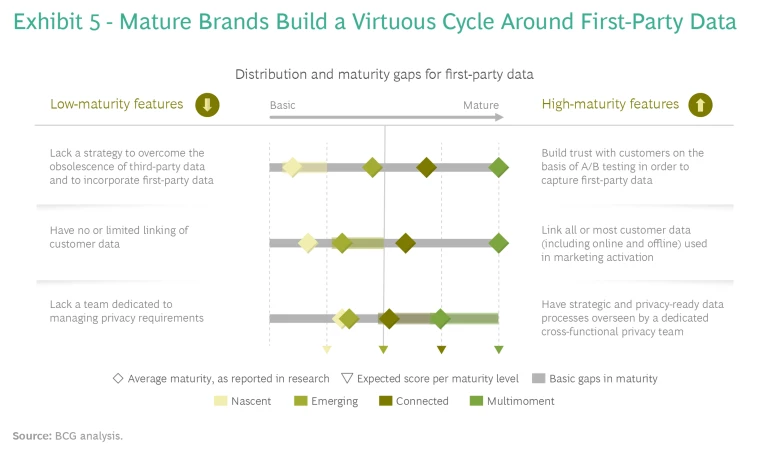
Leaders in advanced organizations ensure that their uses of first-party data comply with applicable regulations and with their own policies, and they build capabilities around the trust-for-value exchange. They make it easy for customers to opt in to communications across channels, by providing a straightforward, candid, and customer-friendly consent process. They then leverage a customer data platform to safely manage the data they collect. “We have more than 13 million members in our loyalty program,” said a travel company executive. “Each piece of information sent has to reinforce trust. We focus on the messages we provide and the value proposition we provide with each of them.” A banking executive told us, “Whenever data needs to be transferred, there is an assessment with an internal cross-functional team to analyze possible risks and how to minimize them. We have an internal process to ensure all uses of data follow privacy requirements.”
Consider how a major bank in South Africa benefited from a first-party data strategy. “We needed a clear understanding of what new and existing customers were looking for,” said the bank’s top digital marketing executive. “We aimed to get more personalized and relevant. Our primary goal was more efficient digital marketing outreach with more product-specific touch points. We realized that the best way to do that was to design an integrated first-party data audience strategy for both online and offline.”
The bank needed a clearer understanding of what new and existing customers were looking for, so it could sharpen the personalization, relevance, and product specificity of its campaigns. It designed an integrated first-party data strategy across both online and offline sources. Using machine learning and predictive lifetime-value models, the bank segmented customers according to the bank’s product range. The segmentation enabled it to create a more personalized customer experience, from creative treatments to landing page.
The bank also applied a test-and-learn approach, another of the four accelerators. “At the beginning of the journey, it wasn’t easy,” the executive said. “For each iteration, we needed to make sure that we were compliant from a privacy perspective and that we followed the correct processes.”
The strategy led to 89% more online leads and 300% better user engagement while also increasing the bank’s efficiency. Revenues rose significantly and costs dropped. After demonstrating the value of the first-party data strategy, the bank rolled it out across all of its international markets.
Companies that have not yet invested in understanding their current sources of data and ensuring basic data quality as a foundation for other capabilities need to start now. More digitally mature organizations may need to invest further in securing all sources of first-party data and establishing a cross-functional data privacy team. All successful brands will build a compelling story for customers across the entire purchasing journey as underpinning for the trust-value exchange of first-party data.
Accelerator 2: End-to-End Measurement
The ability to measure the impact of different types of interactions with customers along the purchasing journey, regardless of channel, is a holy grail of digital marketing. Brands need an effective measurement system to continuously optimize the value exchange with customers, and this requirement will become all the more important as data becomes harder to acquire over the next few years.
The first step toward effective end-to-end measurement is to establish a consistent set of KPIs (common objectives shared across multiple channels and marketing teams) for assessing impact. Aside from those in the nascent category, most brands (78%) have a limited set of metrics—typically five to ten—that inform their marketing investment decision making and allocations across categories, brands, markets, lines of business, and media channels. More advanced companies summarize the relevant reporting on a strategic scorecard or dashboard that supports decision making across various strategic and tactical dimensions.
With the impending loss of third-party data, precision marketing must evolve toward more predictive marketing. Establishing attribution for purposes of advertising and promotion budget allocation requires end-to-end measurement encompassing channels, devices, and predictive models that use advanced analytics to bridge gaps in data (predominantly caused by the loss of third-party cookies). Predictive models help companies gauge the probability value of the different occasions when a customer or potential customer comes into contact with the brand, which in turn enables ROI optimization. A retail executive for an Italian company said, “Attributions based on predictive models are of high importance and add a lot of value, providing information that fills the gaps created by privacy restrictions or multichannel interactions. They enable our company to optimize ROI.”
Even so, some of the more advanced marketers in our study have not built this capability. Only 42% of multimoment companies and 36% of connected companies leverage predictive models.
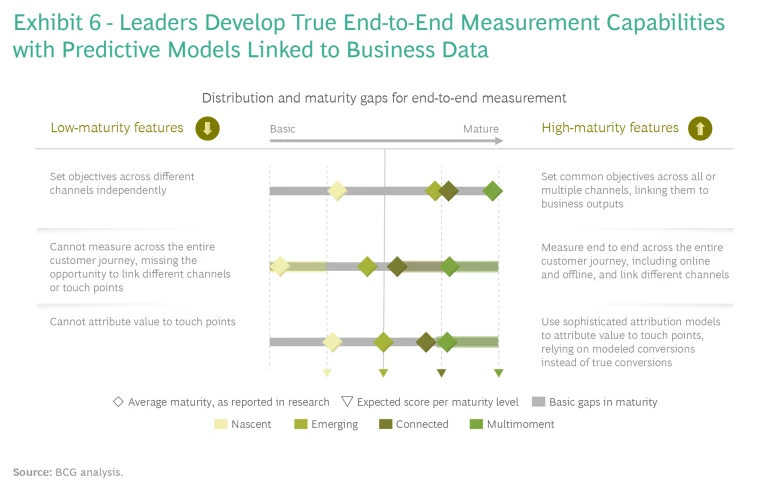
All brands, including multimoment ones, have room for improvement in end-to-end measurement. (See Exhibit 6.) Customers vary widely in their interests, motivation, and behavior (among other factors). In our work on personalization campaigns, we have found that companies tend to focus on overall campaign effectiveness, striving for solutions that work well on average. As a result, they fail to identify pockets of variety among their customers, which is where the real value of personalized outreach lies. A/B testing reveals what works best on average, but companies that want to build deeper relationships with their customers need to adapt campaigns and messages by segment or persona.
To establish true end-to-end measurement capabilities, brands must evolve from focusing on consistent KPIs through cross-channel and cross-device measurement to deploying predictive models along the entire purchasing journey.
Accelerator 3: Agile Performance Loops
The importance of the two technical accelerators has drawn renewed interest in organizational agility. It is hard to build first-party data cycles and apply test-and-learn approaches while still operating in traditional, siloed organizational structures. Nevertheless, most companies lack cross-functional, agile teams that can identify solutions to new needs and get them up and running in days. Likewise, most companies do not have the necessary technological support, such as dashboards that they can share with partners and use to receive digital signals on campaign performance, creating a real-time response capability. Such signals include media KPIs (ROI and return on advertising spending), context (weather, inventories, and calendar events), first-party data (conversions, customer characteristics, and customer interests), and second- and third-party data where still valuable. Our research indicates that 83% of multimoment brands but only 29% of connected brands have in place agile feedback loops that use test-and-learn approaches to permit dynamic responses to emerging needs. (See Exhibit 7.) Having the ability to react dynamically allowed one consumer goods brand to increase its market share by 1.5 percentage points during the pandemic.
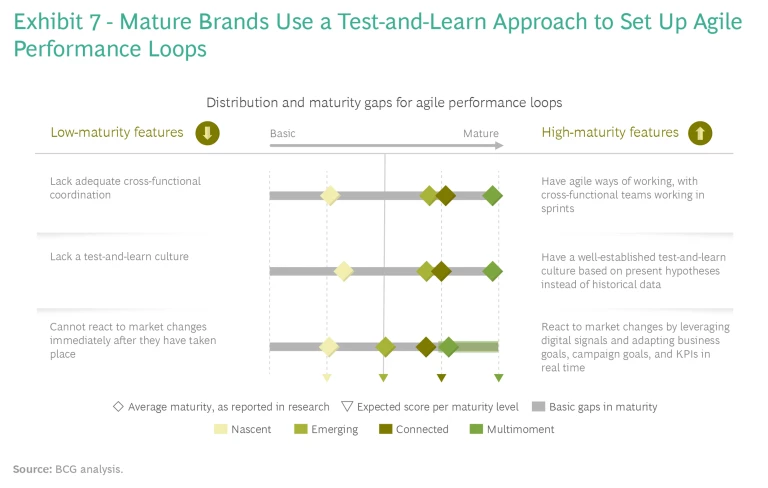
Our experience with agile ways of working has shown that when big companies get agile right, the results can be stunning. Productivity can improve by a factor of three, and development costs can decline by 15% to 25%. Employee engagement, as measured in quantitative surveys, increases dramatically. Companies can release new product features within weeks or months rather than quarters or years. The rate of innovation rises, while defects and do-overs occur less frequently.
Agile teaming also enables companies to break down silos and react nimbly to fast-evolving consumer behavior, in part because it helps them gain access to more and higher-frequency data. Multimoment marketers ensure that the data that the company collects is connected and flows across cross-functional teams including CRM, e-commerce, brand, and performance marketing, and that an informed legal team supports it.
But agile is difficult. The transformation affects everything from how internal processes operate to how employees spend their day to how people in the organization interact. It requires rethinking structures, reporting, compensation, and career paths. Leadership is often the missing ingredient. For organizations to effectively embrace agile ways of working, senior executives must change their ways of working. This isn’t as simple as it sounds: agile behaviors are not the ones that propelled these people into senior leadership positions in the first place. Unlearning approaches that led to personal success in the past is a tall order.
An executive at a multimoment company put it this way: “Our test-and-learn culture has been promoted by the board. They believe in it, and they are willing to invest in it, both by hiring for roles that are test-and-learn oriented and by having the patience to wait for statistically significant results.”
The first step toward establishing agile teaming and a fail-fast test-and-learn culture is to ensure that key functions work together. As people return to the workplace, brands should look to colocate (physically or virtually) cross-functional teams while promoting test-and-learn and even to use digital signals to trace changes. Companies at all levels of maturity need to adapt in automating digital signals.
Accelerator 4: New Skills and Resources
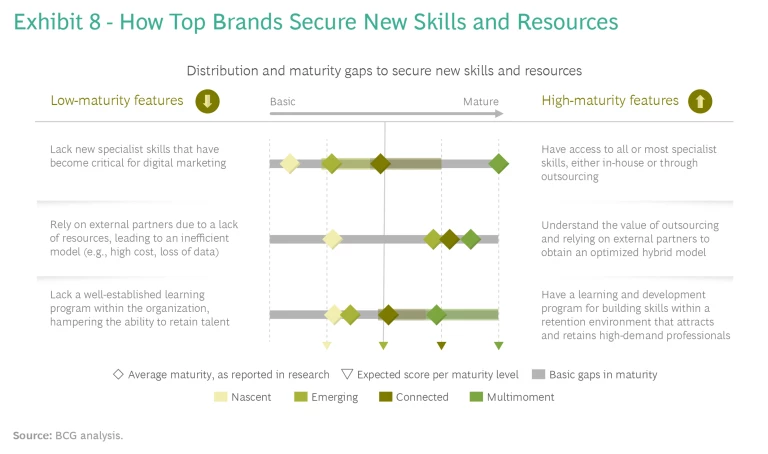
A May 2021 Wall Street Journal article featured the story of a longtime employee at Levi Strauss in the US who rose from stock clerk to store manager—before being retrained by the company as a data scientist. This is hardly uncommon today, and retail is only one sector that faces an acute shortage of technically skilled people. More digitally mature marketers began reorienting their hiring and employee development programs years ago. Others now find themselves behind the curve. (See Exhibit 8, and “New Skills for New Roles.”)
New Skills for New Roles
- Privacy specialist
- Measurement and attribution model expert
- Web analytics expert
- Tag management expert
- Specialist in customer segmentation with aggregated data
- Media strategist
- Paid-media expert
- Content production expert
- Conversion rate optimization expert
- User interface, user experience (UI/UX) designer
- UI/UX research expert
- Marketing technology specialist
To gain access to the skills that they need, many brands are working with external providers, especially to obtain more advanced capabilities, but this leads to two challenges: ensuring adequate access to talent and establishing a practical balance between internal and external resources. Our research indicates that 50% of multimoment brands maintain partnerships across the board but only 10% of brands at other maturity levels make use of the partnerships to the same degree. More advanced companies are experimenting with different models. For example, an Italian telco relies on an internal marketing team to develop specialist skills, whereas a British retailer looks to agencies to leverage talent, noting, “We feel comfortable working with agencies, as we do not lose market perspective.” We have found that five criteria typically determine which capabilities companies insource, outsource, or secure through hybrid models:
- The need for agility and a quick response time
- The scale and complexity of the work
- The sensitivity and value of the data involved
- Economies and cost efficiencies
- The ability to recruit the necessary talent
Many companies in our experience have found the hybrid approach to be highly effective. Often this means insourcing the technology stack and capabilities related to data analysis and activation while leveraging agencies’ ability to provide an unbiased strategic perspective, design creative content, and purchase advertising time slots upfront. A French financial services executive told us, “Relying on external partners is commonsense for us. We prefer to focus on the activities we understand, where we can focus and bring tangible value. For other aspects, we rely on long-term partners.”
To ensure access to skills and resources, brands can first fill skill gaps through partnerships and then develop a more in-depth analysis of the best balance of internal and external capabilities. They can work toward developing the required internal skills by establishing learning programs, and they can limit employee turnover by instituting compelling retention programs. Hiring and retention strategies are most successful when they foster an environment of professional growth that challenges talent to discover new solutions every day. Although more mature organizations have long understood the need for training programs, retention programs have not been a priority at most companies: only 17% of multimoment brands and 13% of connected brands emphasize retention.
Moving Forward
The factors influencing digital marketing maturity will evolve with time, of course, as new technologies disrupt the market and as competitors further develop their capabilities. Nascent and emerging brands have their work cut out for them: unless they move up the maturity curve quickly, they risk becoming irrelevant to consumers.
Connected and multimoment brands must continue to pursue the types of bold investments that have fueled their digital maturity to date—investments that will help them stay on the fast track, increasing their organizations’ agility so that they can adapt to whatever trends the future brings. Even the most advanced multimoment marketers cannot rest on their accomplishments.
For all companies seeking to boost their digital marketing maturity, the four accelerators that we have emphasized here are good place to start. C-suite sponsorship is key at all levels but is especially critical in efforts to move into upper levels of maturity, where organizational coordination is essential. Companies must put customer value and trust at the center of the vision they pursue.
Successful CMOs will push the continuing evolution of their function’s capabilities—further developing end-to-end measurement in assisted channels, for example, and improving their ability to detect market changes digitally and adapt campaigns accordingly. By aligning with stakeholders throughout the organization and working with them to prioritize digital marketing maturity, CMOs can help their brands maximize profitable growth.
The authors are grateful to the following colleagues for their assistance in the preparation of this report: María Alzueta, Abril de Bonis, Eulalia Casas, Jose Luis Casas, Zigor Lapera, Nicole Rapeport, and Shubham Gupta.





